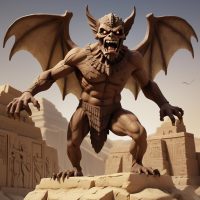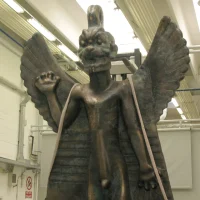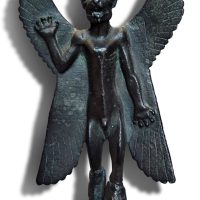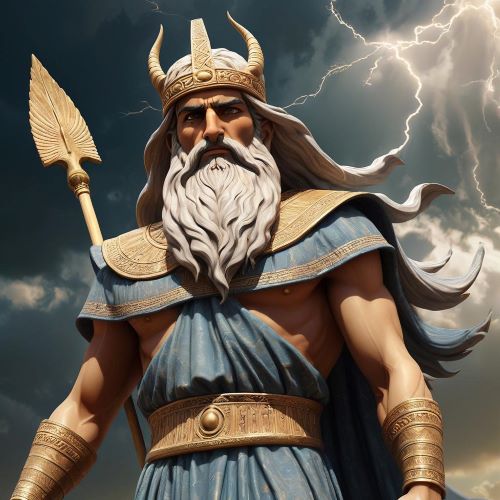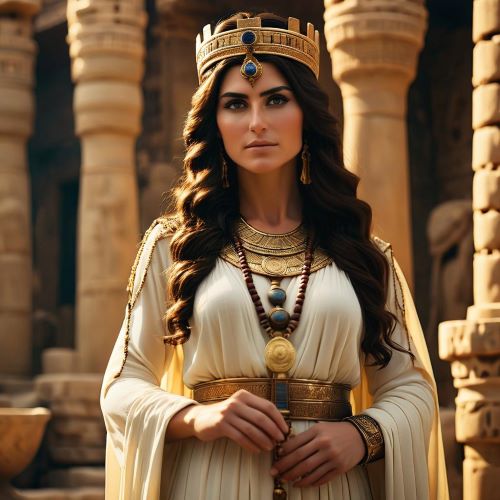Pazuzu : King of Wind Demons
Listen
At a glance
| Description | |
|---|---|
| Origin | Assyrian Mythology |
| Classification | Gods |
| Family Members | Hanpa (Father), Humbaba (Brother) |
| Region | Iraq, Syria, Turkey |
| Associated With | Demons, Wind |
Pazuzu
Introduction
Pazuzu is one of the most complex and paradoxical figures in Mesopotamian mythology, both feared and revered in equal measure. Emerging prominently in Assyrian and Babylonian traditions during the first millennium BCE, Pazuzu was known as the king of wind demons. His appearance was grotesque and terrifying, yet his image was frequently invoked as a source of protection. This duality set him apart from other demonic figures in the Mesopotamian pantheon. While he was associated with the destructive southwest wind that brought droughts and disease, he was equally invoked to ward off the dangers posed by other malevolent beings, most notably the terrifying demoness Lamashtu. Thus, Pazuzu embodies the ambiguity of Mesopotamian demonology, representing both chaos and protection.
Physical Traits
The iconography of Pazuzu is among the most distinctive in ancient Mesopotamia. His figure combines human and animal characteristics in a way that makes him instantly recognizable. Typically, he is shown with a human-like body, but his head is either canine or leonine, with glaring eyes, a snarling mouth displaying teeth and tongue, and exaggerated eyebrows that create an aura of menace. His lower body contrasts sharply with this face, featuring taloned bird-like feet and a scorpion’s tail, reinforcing his threatening power. Two pairs of wings extend from his back, a clear symbol of his dominion over the winds. Perhaps his most unsettling feature is the snake-headed penis, which, along with the scaly texture of his torso, adds to his monstrous form.
Interestingly, the archaeological record shows Pazuzu appearing fully developed in iconography without the gradual evolution seen in depictions of many other deities. His earliest known representations, often in the form of small terracotta heads or amulets, already contain all these defining features. This sudden emergence has puzzled scholars, who see in his figure a deliberate creation meant to embody and personify multiple aspects of fearsome natural forces.
Family
Pazuzu is described in Mesopotamian lore as the son of Hanpa (also called Hanbi), a deity often identified as the king of wind demons. Hanpa himself remains an obscure figure, mentioned primarily in association with Pazuzu. Some sources attempt to link Pazuzu with Humbaba, the monstrous guardian of the Cedar Forest from the Epic of Gilgamesh, suggesting they were brothers. However, this connection is not supported by reliable cuneiform texts and is likely a later misinterpretation.
Despite the scarcity of details about his immediate family, what is clear is that Pazuzu is portrayed as one of the most powerful offspring of Hanpa. Legends also suggest a complicated and antagonistic relationship with the demoness Lamashtu. While she preyed on pregnant women and infants, Pazuzu was invoked as her adversary, capable of driving her away. In some accounts, this enmity is given a mythological backstory that includes an earlier relationship between the two, which later dissolved into bitter hostility. This rivalry shaped his role as both a terrifying figure and a paradoxical guardian.
Other names
Though most widely recognized as Pazuzu, this figure was also known by alternative names and titles in different cultural and textual contexts. In some later interpretations, he appears under the name Pazuzeus, while in esoteric traditions outside Mesopotamia, he has been linked with figures such as Pazrael or Typhon. His Sumerian counterpart is sometimes identified with Imdugud, a monstrous bird-like being, though the association is not universally accepted by scholars.
Ancient Mesopotamian texts occasionally use evocative epithets for Pazuzu, calling him the “Agony of Mankind,” “Suffering of Mankind,” or “Disease of Mankind.” Yet in magical incantations and amulets, he could also be invoked as the “Dark Angel of the Four Winds” or even as a household protector. These multiple designations illustrate how fluid his identity was: a being of destruction, but also one that people could turn to when desperate for protection against even greater threats.
Powers and Abilities
Pazuzu’s powers were immense and deeply tied to his elemental domain—the winds. The southwest wind, under his control, was feared for carrying drought, pestilence, and locusts, making him an embodiment of the destructive forces of nature. Yet paradoxically, his presence was considered vital for warding off other demons. The most notable example of this is his role as a protector against Lamashtu, who threatened mothers and infants. Amulets bearing his figure were commonly placed in homes or worn by pregnant women to safeguard them during childbirth.
In myths, Pazuzu was said to have battled rival wind demons, climbing great mountains to confront them and shattering their wings. This imagery reinforces his position as a dominant force among spirits of the air. His reputation alone was believed to drive lesser demons into hiding. The magical texts of Mesopotamia describe him as a powerful figure in incantations, able to inflict disease but also to repel it. His powers extended to possession, dark sorcery, invisibility, and manipulation of natural forces. Unlike many other demons, he combined raw destructive potential with an ability to shield humans, making him indispensable in Mesopotamian protective magic.
Modern Day Influence
Although Pazuzu’s origins are firmly rooted in the religious practices of ancient Mesopotamia, his image has endured into modern times, often in unexpected ways. The most famous example is his role in William Peter Blatty’s novel The Exorcist (1971) and its iconic 1973 film adaptation, where Pazuzu is portrayed as the possessing demon tormenting a young girl. While this depiction exaggerates his purely malevolent side, it cemented his place in modern horror culture. The film’s opening scenes, featuring a statue of Pazuzu unearthed in Iraq, accurately reflect the archaeological record of small statuettes used in Mesopotamia for protection.
Beyond The Exorcist, Pazuzu has appeared in comic books, television shows like Constantine and Supernatural, and video games such as House of Ashes. He even makes satirical appearances in pop culture, including The Simpsons’ Halloween specials. His name surfaces in music, literature, and neo-pagan texts like the Simon Necronomicon, although these often deviate significantly from Mesopotamian tradition.
Museums such as the British Museum and the Louvre house artifacts depicting Pazuzu, ensuring that he remains accessible to both scholars and the public. Academically, he has become a focal point in the study of demonology, ritual magic, and gendered protection in ancient societies. In digital platforms and educational resources, Pazuzu is frequently discussed as a prime example of Mesopotamian mythology’s complexity.
His enduring legacy lies in the contradiction he represents: a grotesque demon who inspired terror yet was embraced as a powerful protector. This tension continues to fascinate modern audiences, ensuring that Pazuzu remains not only a relic of Mesopotamian religion but also a recurring presence in global popular culture.
Related Images
Source
Wikipedia contributors. (2025). Pazuzu. Wikipedia. https://en.wikipedia.org/wiki/Pazuzu
BabylonianMyths. (2025, May 28). The Myth of the Babylonian Demon Pazuzu. Babylonian Mythology Worldwide. https://babylonian.mythologyworldwide.com/the-myth-of-the-babylonian-demon-pazuzu/
Kulik, R. M. (2025). Pazuzu Mesopotamia, Demon, & Description. Encyclopaedia Britannica. https://www.britannica.com/topic/Pazuzu
Black, J., & Green, A. (1992). Gods, Demons and Symbols of Ancient Mesopotamia: An Illustrated Dictionary. University of Texas Press.
Leick, G. (1998). A Dictionary of Ancient Near Eastern Mythology. Routledge.
Wiggermann, F. A. M. (1992). Mesopotamian Protective Spirits: The Ritual Texts. Brill Academic Publishers.
Scurlock, J. A. (2006). Magico-Medical Means of Treating Ghost-Induced Illnesses in Ancient Mesopotamia. Brill.
Gabbay, U. (2010). The king of the demons: Pazuzu, Bagdana and Ašmedai. https://www.torrossa.com/gs/resourceProxy?an=2466357&publisher=FZ1670#page=58
Frequently Asked Questions
What is lorem Ipsum?
I am text block. Click edit button to change this text. Lorem ipsum dolor sit amet, consectetur adipiscing elit. Ut elit tellus, luctus nec ullamcorper mattis, pulvinar dapibus leo.
What is lorem Ipsum?
I am text block. Click edit button to change this text. Lorem ipsum dolor sit amet, consectetur adipiscing elit. Ut elit tellus, luctus nec ullamcorper mattis, pulvinar dapibus leo.
What is lorem Ipsum?
I am text block. Click edit button to change this text. Lorem ipsum dolor sit amet, consectetur adipiscing elit. Ut elit tellus, luctus nec ullamcorper mattis, pulvinar dapibus leo.
What is lorem Ipsum?
I am text block. Click edit button to change this text. Lorem ipsum dolor sit amet, consectetur adipiscing elit. Ut elit tellus, luctus nec ullamcorper mattis, pulvinar dapibus leo.
What is lorem Ipsum?
I am text block. Click edit button to change this text. Lorem ipsum dolor sit amet, consectetur adipiscing elit. Ut elit tellus, luctus nec ullamcorper mattis, pulvinar dapibus leo.


